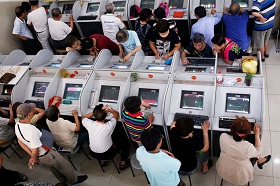In late November 2015, the International Monetary Fund (IMF) Executive Board decided to include the Chinese renminbi in the reserve currency basket. The position of the IMF undoubtedly shows its confidence in the prospects for the Chinese economy, which has been “breathing down the neck” of the U.S. economy in recent years. At the end of the day, the IMF had no choice but to include the currency of the world’s second biggest economy in the honorary list of SDR currencies, as it helps the IMF preserve its global legitimacy.
In late November 2015, the International Monetary Fund (IMF) Executive Board decided to include the Chinese renminbi in the reserve currency basket. According to IMF Managing Director Christine Lagarde, this is a recognition of the progress that the Chinese authorities have made in recent years to reform the country’s monetary and financial systems.
The decision comes into force on October 1, 2016. Up until now, the reserve currencies in the Special Drawing Rights (SDR) basket [1] were the U.S. dollar, the euro, the British pound and the Japanese yen. The IMF has announced that the renminbi’s share of the basket will be 10.92 per cent, bigger than that of the British pound (8.09 per cent) and the Japanese yen (8.33 per cent). The U.S. dollar, though, with a diminished share (41.73 per cent) remains the largest reserve currency, with the euro accounting for 30.93 per cent.
The Chinese renminbi has already come to be considered a “freely usable currency” in recent years, because it is used in settlements all over the world. According to the SWIFT interbank information transmission system, by the end of summer 2015, the share of the renminbi in international settlements had grown 2.79 per cent, putting it ahead of the yen for the first time. In 2010, when the basket was last reviewed, the IMF refused to include the renminbi in the prestigious list on the grounds that, at the time, the Chinese currency did not meet the free use requirement. The renminbi has made spectacular progress over the past five years, moving from 35th place in late 2010 to fifth place in 2015. It has become the most common currency in settlements in the Asia-Pacific Region.
Preparing for the IMF vote, China opened access to its domestic foreign exchange and bonds markets for foreign central banks, and increased the role of the Bank of China in determining the daily trading range for the renminbi.
However, these measures, taken to ensure compliance of the renminbi with the “free circulation criteria”, have yet to withstand the test of time
The decision to include the renminbi in the SDR currency basket has received with a mixed reaction from analysts around the world. Nobody disputes China’s obvious success over the past decade, during which it has become a serious rival of leading global economies. In 2010, it became the biggest exporter of goods in the world. However, at a time when economic growth is slowing down, the Chinese economy is creating problems for the financial and commodities markets. If the Chinese economy continues to slow down in the years to come, it will overturn the arguments of those who today believe that the inclusion of the renminbi in the SDR basket will give it positive impetus.
As Deputy Governor of the People’s Bank of China, Yi Gang, said immediately after the IMF’s historic decision, the country is prepared to cope with all the risks that may arise after the renminbi is included in the world currency basket, notably keeping the renminbi’s exchange rate stable. These are serious obligations. Thus, the IMF may demand that Beijing refrain from currency interventions and renounce control over the movement of capital.
However, the unprecedented boom of China’s economy and the growing use of the renminbi in international settlements are not enough to include its national currency in the SDR basket. It turns out that the Chinese renminbi is behind the Canadian and Australian dollars (which are not in the IMF’s reserve currency basket) on a number of counts – the use by central banks as reserve currency or as borrowing currency in the capital markets, for example. According to the latest IMF data, the share of the renminbi in the structure of international currency reserves is a mere 1.1 per cent, compared to 63.7 per cent for the U.S. dollar. Besides, the renminbi will differ from other reserve currencies because it will be the only reserve currency with a fixed exchange rate. The renminbi cannot be bought and sold freely. It will only become freely convertible in 2020. Experts point out that if it was not the Chinese renminbi, but the currency of some other state, the IMF would not have made such concessions
This suggests that the IMF has turned a blind eye on certain things and that its decision to include the renminbi in the reserve currency basket is politically motivated. This was the opinion of the prestigious Peterson Institute for International Economics in Washington, for example. The concessions may have been prompted by the desire to placate China, which is unhappy with the redistribution of votes and quotas at the IMF. Under an IMF decision of 2010, the quota of BRIC countries in the Fund was increased from 10.71 per cent to 14.18 cent, with China and Russia receiving a corresponding increase of shares.
However, the United States Congress blocked the reforms. This prompted Beijing to start creating alternative currency and monetary institutions, which is highly undesirable for the existing world financial system largely controlled by the United States.
However, from the viewpoint of the IMF leadership, the latest reform of the currency basket is no more than a technical procedure. This is because it reflects the real situation, where the renminbi is used in transactions between IMF members. At the same time, the position of the IMF undoubtedly shows its confidence in the prospects for the Chinese economy, which has been “breathing down the neck” of the U.S. economy in recent years. At the end of the day, the IMF had no choice but to include the currency of the world’s second biggest economy in the honorary list of SDR currencies, as it helps the IMF preserve its global legitimacy.
1. Special Drawing Rights (SDR) were introduced by the IMF in 1969 as a supplementary international reserve asset on the basis of the reserve currency basket that existed at the time.






